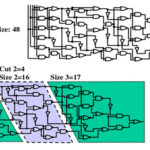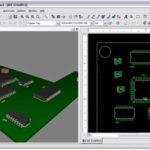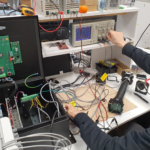According to The World Semiconductor Trade Statistics (WSTS) — a non-profit organization of semiconductor product companies and source for industry statistics — the electronic design automation (EDA) market was valued at $11.57 billion in 2020 and is expected to reach $21.36 billion by 2026.
EDA refers to using computer-aided tools and services for the design, manufacture, verification, and performance testing of highly complex electronic systems — including semiconductor chips, printed circuit boards, multi-chip modules, and microprocessors.
Interestingly, the WSTS found that the integrated circuit (IC) semiconductor market was worth $347.63 billion in 2020, and that figure is likely to increase.
EDA tools ensure reliable, efficient, and (often) reusable performance-guaranteed electronic chips and circuit boards. In this article, we’ll explore the significance of electronic design automation and review the more popular EDA tools amongst engineers.

What is EDA?
EDA entails a specific category of hardware, software, processes, and services that use computer-related design to develop sophisticated, highly complex electronic systems. As mentioned, these include integrated circuits, printed circuit boards, multi-chip modules, and microprocessors.
EDA tools are useful for automating, standardizing, and verifying semiconductor and circuit board designs. The tools have become essential given today’s advanced and intricate chips and circuits. Using computer-aided tools also supports the development of re-usable designs, leading to more rapid manufacturing of ICs and printed circuit boards.
Although semiconductor companies produce integrated circuits, the EDA industry plays a critical role in this manufacturing. EDA tools are involved in three main ways. They’re used to:
1. Design and validate chip circuits to ensure the desired density without compromising performance. Without these tools, it would likely be impossible to achieve the optimum semiconductor designs we see today. Typically, this tool design category is called Technology Computer-Aided Designs (TCAD).
2. Verify designs, ensuring they meet manufacturing requirements. The smallest discrepancies in semiconductor designs can potentially lead to failures or significant chip malfunctioning. These tools are considered, Design For Manufacturability (DFM). The DFM tools specifically refer to manufacturing reliable and reusable IC designs with high-packing density.
3. To monitor the performance of semiconductor designs throughout their lifecycle. Different tools evaluate the designs depending on the production stage, including from post-manufacturing to final deployment. These EDA tools are categorized as Silicon Lifecycle Management (SLM).
Each EDA tool that’s involved in IC manufacturing falls into one of the three categories: TCAD, DFM, or SLM.
For circuit boards, EDA tools are used for computer-supported layout designs and automation control for PCB manufacturing. A somewhat newer area of tool use is for Semiconductor Intellectual Property (IP).
Semiconductor IP provides pre-designed circuits that can be integrated as-it-is in various applications. This segment focuses on semiconductor designs that can be frequently reused and easily adapted for several use-cases. This provides for rapid development and upgrading of electronic systems.
Why EDA is important?
Very Large-Scale Integration (VLSI) and Ultra Large-Scale Integration (ULSI) have become the norms of the semiconductor industry. With such high levels of packing density — wherein millions of transistors, diodes, and components are integrated into a small chip — a minute flaw can lead to complete dysfunction.
EDA tools let developers design, simulate, model, validate, verify, and analyze circuit designs to detect potential problems before production. They also allow for the maintenance and reusability of designs so they can easily be adapted to other applications (such as for the Semiconductor IP). Additionally, the tools contribute to improved designs over time.
In the future, expect denser designs with greater complexities, meaning the EDA tools will become even more evolved and relied on in the semiconductor and PCB industries.
EDA applications
EDA is a software industry that works closely with semiconductor and PCB manufacturers. Industries using embedded systems, mechatronics, and photonics are also now relying heavily on EDA tools. These tools are widely used by vertical technology users like aerospace, automotive, biomedical, telecommunication, cyber security, machine learning, cloud computing, consumer, edge computing, the internet of things, and automation.
Essentially, EDA tools have become a must for the development, automation, and testing of electronic systems design whether these systems are semiconductor chips, multi-chip modules, or printed circuit boards.
How EDA works
EDA tools are an integral part of the infrastructure for designing and developing electronic systems. They’re typically used for:
Simulation: Simulation tools input a description of a proposed circuit and predict its behavior before implementation. The description is done with the help of a standard hardware description language, such as VHDL or Verilog.
The simulation tools model the circuit behavior of individual components in different conditions and predict how they would behave when integrated into a circuit. Based on the operation of the components, these tools predict the overall function of the circuit design while detecting possible flaws.
For heavily packed designs, like graphic processors or NPUs, simulation tools might also require hardware assistance. Such tools are useful for logic simulation, transistor-level simulation, Technology CAD, and hardware emulation.
Design: Design tools input the proposed circuit function, supporting its implementation by assembling the circuit components. These tools are useful in automating circuit production and validating the designs before production. They typically interconnect elements on the logical and physical levels.
The interconnection of circuit elements at the logical level is logical synthesis. This can involve high-level synthesis where the HDL is converted to the register transfer level.
Additionally, design tools are used for the physical layout or actual place and route of components on a silicon wafer or circuit board. They can also provide customized layouts using an interactive process with the circuit designer.
Analysis and verification: Verification tools examine designs at the logical or physical level to find any faults and ensure performance. These tools can be used for physical verification, model checking, functional verification, equivalence checking, static timing analysis, and CDC checking.
Because of the complexity of VLSI designs, the verification often involves tens of thousands of rules.
- During the physical verification, interconnected geometrics are examined to ensure they’re placed according to the manufacturing requirements of the foundry.
- During the functional verification, the simulation compares what’s expected with the actual behavior of the circuit design.
- During the equivalence checking, the behavior of a circuit design is verified algorithmically without any input simulation.
EDA tools are also used for Mask Data Preparation during manufacturing semiconductor chips and post-production functional safety analysis.
The role of EDA tools is significant because they’re involved throughout the lifecycle of a chip or circuit, from planning, designing, implementing, manufacturing, and testing.
Top EDA tools
Some of the top EDA tools used in PCB design and manufacturing include Eagle, KiCAD, Multisim, LibrePCB, gEDA, Fritzing, Pulsonic, Altium, OrCAD, Upverter, EasyEDA, Pathwave Advanced Design System, Pcb-rnd, QUCS, Electric, and Xcircuit.
Some of the top EDA tools used in chip design and development include Primetime, Innovus, Calibre, Pathwave, Magic, IDesignSpec, IVerifySpec, Active-HDL, Visula, Electric VLSI Design System, Xilinx Vivado, SmartSim, and Verilator.
You may also like:
Filed Under: Tech Articles








Questions related to this article?
👉Ask and discuss on EDAboard.com and Electro-Tech-Online.com forums.
Tell Us What You Think!!
You must be logged in to post a comment.